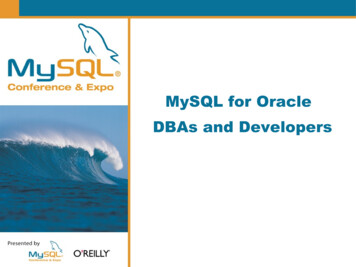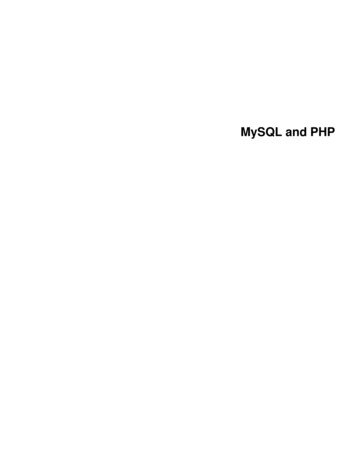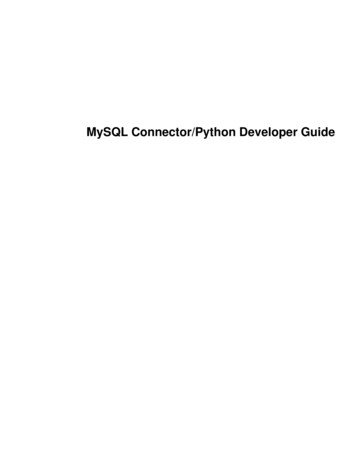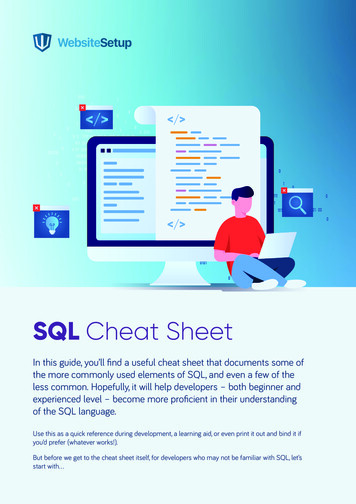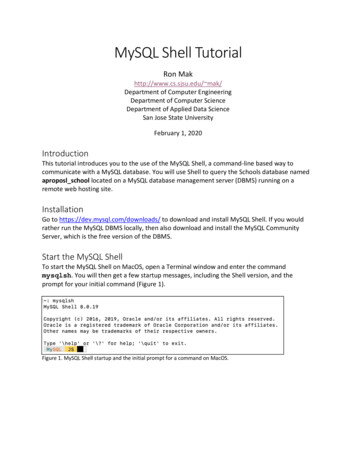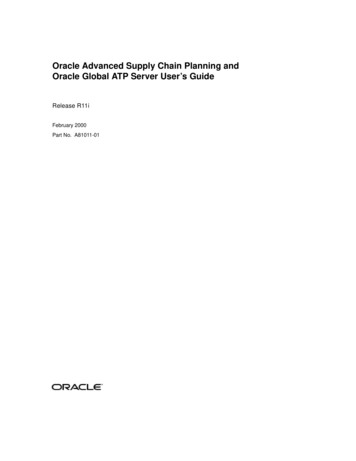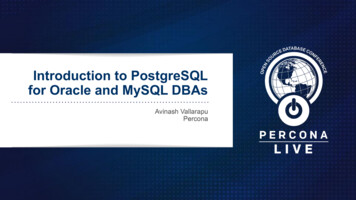
Transcription
Introduction to PostgreSQLfor Oracle and MySQL DBAsAvinash VallarapuPercona
The History of PostgreSQLIngresYear 1973 - INGRES (INteractive GRaphics Retrieval System) work on one of the world's first RDBMS was started byEugene Wong and Michael Stonebraker at University of California at BerkeleyYear 1979 - Oracle Database first version was releasedEarly 1980’s - INGRES used QUEL as its preferred Query Language. Whereas Oracle used SQLYear 1985 - UC Berkeley INGRES research project officially endedPostgresYear 1986 - Postgres was introduced as a Post-Ingres evolution. Used POSTQUEL as its query language until 1994Year 1995 - Postgres95 replaced Postgres with its support for SQL as a query languagePostgreSQLYear 1996 - Project renamed to PostgreSQL to reflect the original name Postgres and its SQL CompatibilityYear 1997 - PostgreSQL first version - PostgreSQL 6.0 released2
PostgreSQL Features Portable Written in CFlexible across all the UNIX platforms, Windows, MacOS and othersWorld’s most advanced open source database. Community-drivenANSI/ISO Compliant SQL support ACID CompliantSupports TransactionsUses Write Ahead Logging MVCCTable e3
PostgreSQL Advanced Features Security High Availability Host-Based Access ControlObject-Level and Row-Level SecurityLogging and AuditingEncryption using SSLSynchronous/Asynchronous Replication and Delayed StandbyCascading ReplicationOnline Consistent Physical Backups and Logical BackupsPITROther Features Triggers and Functions/Stored ProceduresCustom Stored Procedural Languages like PL/pgSQL, PL/perl, PL/TCL, PL/php, PL/python, PL/java.PostgreSQL Major Version Upgrade using pg upgradeUnlogged Tables, Parallel Query, Native Partitioning, FDWsMaterialized ViewsHot Standby - Slaves accept Reads4
PostgreSQL Cluster After Initializing your PostgreSQL using initdb (similar to mysqld --initialize) and starting it, you cancreate multiple databases in it A group of databases running on one Server & One Port - Is called a Cluster in PostgreSQL PostgreSQL Cluster may be referred to as a PostgreSQL Instance as well A PostgreSQL Cluster or an Instance: Serves only one TCP/IP Port Has a Dedicated Data Directory Contains 3 default databases: postgres, template0 and template1 When you add a Slave(aka Standby) to your PostgreSQL Cluster(Master), it may be referred to as aPostgreSQL High Availability Cluster or a PostgreSQL Replication Cluster PostgreSQL Cluster that can accept Writes and ships WALs to Slave(Standby), is called a Master5
PostgreSQL Database and Schema A PostgreSQL Database can contain one or more Schemas Default Schema is - public schema A Schema in PostgreSQL is a logical entity that helps you groupobjects of a certain Application logic together. This helps you createmultiple objects with the same name in one Database A Database can be related to a Parent Folder/Directory.You canalways have more than 1 Database with one or more Schemas in it For example: In a Database named percona, a Table employee canexist in both scott and tiger schemasDatabase: perconaSchema(s): scott & tigerTables: 1. scott.employee2. tiger.employee A Fully Qualified Table Name: schemaname.tablename must be usedto query a particular Table in a SchemaFor example:select * from scott.employee where salary 10000;6
PostgreSQL ACID Compliance Atomicity:Transactions. Either All or NothingBEGIN SQL1, SQL2, SQLn .COMMIT/ROLLBACK/END Consistency: Give me a consistent picture of the data based on Isolation LevelsLet us see the following example when Isolation Level is READ COMMITTEDQuery 1 : select count(*) from employees;9am: Records in employee table: 100009:10 am: Query 1 Started by User 19:11am: 2 employee records deleted by User 29:12am: Query 1 that was started by User 1 CompletedResult of Query 1 at 9:12am would still be 10000. A Consistent image as how it was at 9:00am Isolation:Prevent Concurrent data access through Locking Durability:Once the Data is committed, it must be safeThrough WAL’s, fsync, synchronous commit, Replication7
PostgreSQL Terminology PostgreSQL was designed in academia Objects are defined in academic terms Terminology based on relational calculus/algebra8
PostgreSQL Installation
PostgreSQL Installation Using RPM’sPGDG Repository : PostgreSQL Global Development Group maintains YUM and APT repositoryFor YUMhttps://yum.postgresql.orgFor APThttps://apt.postgresql.org/pub/repos/apt/Step 1:Choose the appropriate rpm that adds pgdg repo to your server# yum install https://yum.postgresql.org/11/redhat/rhel-7.5-x86 64/pgdg-centos11-11-2.noarch.rpmStep 2:Install PostgreSQL using the following step# yum install postgresql11 postgresql11-contrib postgresql11-libs postgresql11-server10
Initialize Your First PostgreSQL Cluster initdb is used to Initialize a PostgreSQL cluster echo "PATH /usr/pgsql-11/bin: PATH" /.bash profile source .bash profile echo PGDATA/var/lib/pgsql/11/data initdb --versioninitdb (PostgreSQL) 11.0 initdb11
12
Starting and Stopping a PostgreSQL PostgreSQL can be stopped and started from command line using pg ctl Starting PostgreSQL pg ctl -D PGDATA start Stopping PostgreSQL pg ctl -D PGDATA stop13
Shutdown Modes in PostgreSQL -ms (Smart Mode - Default mode) Waits for all connections to exit and does not allow new transactions Committed transactions applied to Disk through a CHECKPOINT before shutdown May take more time on busy systems pg ctl -D PGDATA stop -ms -mf (Fast Mode - Recommended on Busy Systems) Closes/Kills all the open transactions and does not allow new transactions. SIGTERM is sent to server processesto exit promptly Committed transactions applied to Disk through a CHECKPOINT before shutdown Recommended on Busy Systems pg ctl -D PGDATA stop -mf -mi (Immediate Mode - Forced and Abnormal Shutdown during Emergencies) SIGQUIT is sent to all the processes to exit immediately, without properly shutting down Requires Crash Recovery after Instance Start Recommended in Emergencies pg ctl -D PGDATA stop -mi14
psql and shortcuts Connect to your PostgreSQL using psql psqlList the databases\l\l (Observe the difference)To connect to your database\c dbnameList Objects\dt - List all the tables\dn - List all the schemas Show all backslash (shortcut) commands\?15
PostgreSQL Architecture
PostgreSQL Server Multi-Process Architecture Postmaster (Parent PostgreSQL Process) Backend Utility Processes Per-Connection backend processes17
Background Utility ProcessesStart your PostgreSQL Instance and see the Postgres processes18
19
PostgreSQL Components Postmaster: Master database control process Responsible for startup and shutdown Spawning other necessary backend processes20
Utility Processes BGWriter: Background Writer Writes/Flushes dirty data blocks to disk WAL Writer: Writes WAL Buffers to Disk WAL Buffers are written to WALs(Write-Ahead Logs) on the Disk Autovacuum: Starts Autovacuum worker processes to start a vacuum and analyze Checkpointer: Perform a CHECKPOINT that ensures that all the changes are flushed to Disk Depends on configuration parameters21
Utility Processes Archiver: Archives Write-Ahead-Logs Used for High Availability, Backups, PITR Logger: Logs messages, events, error to syslog or log files. Errors, slow running queries, warnings,.etc. are written to log files by this Process Stats Collector: Collects statistics of Relations.22
Utility Processes WAL Sender: Sends WALs to Replica(s) One WAL Sender for each Slave connected for Replication WAL Receiver: Started on a Slave(aka Standby or Replica) in Replication Streams WALs from Master bgworker: PostgreSQL is extensible to run user-supplied code in separate processes that are monitored byPostgres Such processes can access PostgreSQL's shared memory area Connect as a Client using libpq bgworker: logical replication launcher Logical Replication between a Publisher and a Subscriber23
Memory Components Shared Buffers: PostgreSQL Database Memory AreaShared by all the Databases in the ClusterPages are fetched from Disk to Shared Buffers during Reads/WritesModified Buffers are also called as Dirty BuffersParameter : shared buffers sets the amount of RAM allocated to shared buffersUses LRU Algorithm to flush less frequently used buffers Dirty Buffers written to disk after a CHECKPOINT WAL Buffers: Stores Write Ahead Log Records Contains the change vector for a buffer being modified WAL Buffers written to WAL Segments(On Disk) work mem: Memory used by each Query for internal sort operations such as ORDER BY and DISTINCT Postgres writes to disk(temp files) if memory is not sufficient24
Memory Components maintenance work mem: Amount of RAM used by VACUUM, CREATE INDEX, REINDEX like maintenance operations Setting this to a bigger value can help in faster database restore25
PostgreSQL Does Not Use Direct IO When it needs a Page(Data Block), it searches it’s own memory aka Shared BuffersIf not found in shared buffers, it will request the OS for the same blockThe OS fetches the block from the Disk and gives it to Postgres, if the block is not found in OS CacheMore important to Caching when Database and Active Data set cannot fit in memory26
Disk Components Data Directory In MySQL, Data Directory is created when you initialize your MySQL Instance Initialized using initdb in PostgreSQL. Similar to mysqld --initialize Contains Write-Ahead-Logs, Log Files, Databases, Objects and other configuration files You can move WAL’s and Logs to different directories using symlinks and parameters Environment Variable: PGDATA Configuration Files inside the Data Directory postgresql.conf (Similar to my.cnf file for MySQL) Contains several configurable parameters pg ident.conf pg hba.conf postgresql.auto.conf27
What’s Inside Data Directory?28
Configuration Files Inside Data Directory? PG VERSION Version String of the Database Cluster pg hba.conf Host-Based access control file (built-in firewall) pg ident.conf ident-based access file for OS User to DB User Mapping postgresql.conf Primary Configuration File for the Database postmaster.opts Contains the options used to start the PostgreSQL Instance postmaster.pid The Parent Process ID or the Postmaster Process ID29
postgresql.conf vs postgresql.auto.conf postgresql.conf Configuration file for PostgreSQL similar to my.cnf for MySQLThis file contains all the parameters and the values required to run your PostgreSQL InstanceParameters are set to their default values if no modification is done to this file manuallyLocated in the data directory or /etc depending on the distribution you choose and the location canbe modifiable postgresql.auto.conf PostgreSQL gives Oracle like compatibility to modify parameters using "ALTER SYSTEM"Any parameter modified using ALTER SYSTEM is written to this file for persistenceThis is last configuration file read by PostgreSQL, when started. Empty by defaultAlways located in the data directory30
View/Modify Parameters in postgresql.conf Use show to view a value set to a parameter psql -c "show work mem" To see all the settings, use show all psql -c "show all" Modifying a parameter value by manually editing the postgresql.conf file vi PGDATA/postgresql.conf Use ALTER SYSTEM to modify a parameter psql -c "ALTER SYSTEM SET archive mode TO ON" pg ctl -D PGDATA restart -mf Use reload using the following syntax to get the changes into effect for parameters not needing RESTART psql -c "select pg reload conf()"Or pg ctl -D PGDATA reload31
Base Directory and Datafiles on Disk Base Directory Contains Subdirectories for every Database you create Every Database Sub-Directory contains files for every Relation/Object created in the Database Datafiles Datafiles are the files for Relations in the base directoryBase Directory contains RelationsRelations stored on Disk as 1GB segmentsEach 1GB Datafile is made up of several 8KB Pages that are allocated as neededSegments are automatically added unlike Oracle32
Base Directory (Database)1. Create a database with name as: percona psql -c "CREATE DATABASE percona"2. Get the datid for the database and see if it exists in the base directory psql -c "select datid, datname from pg stat database where datname 'percona'"33
Base Directory (Schema and Relations)1. Create a schema named: scott psql -d percona -c "CREATE SCHEMA scott"2. Create a table named: employee in scott schema psql -d percona -c "CREATE TABLE scott.employee(id int PRIMARY KEY, name varchar(20))"3. Locate the file created for the table: scott.employee in the base directory psql -d percona -c "select pg relation filepath('scott.employee')"34
Base Directory (Block Size)1. Check the size of the table in the OS and value of parameter: block size psql -c "show block size"2. INSERT a record in the table and see the size difference psql -d percona -c "INSERT INTO scott.employee VALUES (1, 'frankfurt')"3. INSERT more records and check the size difference psql -d percona -c "INSERT INTO scott.employee VALUES (generate series(2,1000), 'junk')"35
Write-Ahead Logs (WAL) WALs When Client commits a transaction, it is written to WAL Segments (on Disk) before a successmessage is sent to Client Transaction Journal aka REDO Logs. Similar to InnoDB Buffers in MySQL Written by WAL Writer background process Ensures Durability with fsync and synchronous commit set to ON and commit delay set to 0 Used during Crash Recovery Size of each WAL is 16MB. Modifiable during Initialization Created in pg xlog directory until PostgreSQL 9.6Location of WALs is renamed to pg wal fromPostgreSQL 10 WAL Directory exits in Data Directory by default. Can be modified using Symlinks WALs are deleted depending on the parameters : wal keep segments and checkpoint timeout36
WAL Archiving? Archived WALs WALs in pg wal or pg xlog are gone after a certain threshold. Archiving ensures recoverability andhelps a Slave catch-up during replication lag Archiving in PostgreSQL can be enabled through parameters : archive mode and archive command Ships WALs to safe locations like a Backup Server or Cloud Storage like S3 or Object Store WALs are archived by archiver background process archive command can be set with the appropriate shell command to archive WALs Lets enable Archiving now psqlALTER SYSTEM SET archive mode TO 'ON';ALTER SYSTEM SET archive command TO 'cp %p /var/lib/pgsql/archive/%f'; pg ctl -D PGDATA restart -mf37
Switch a WAL Switch a WAL and see if the WAL is safely archived psql -c "select pg switch wal()"38
What if Archiving Failed?If archiving has been enabled and the archive command failed, the WAL segment for which the archiving failed will not be removed from pg wal or pg xlog an empty wal file name.ready file is generated in the archive status directory the background process archiver attempts to archive the failed WAL segment until it succeeds there is a chance that the pg wal directory can get filled and doesn't allow any more connections todatabase39
40
Users and Roles in PostgreSQL Database users are different from Operating System users Users can be created in SQL using CREATE USER command or using the createuser utility Database users are common for all the databases that exists in a cluster Roles are created to segregate privileges for access control41
Users and Roles in PostgreSQL - Demo Let us consider creating a read only and a read write role in database - percona A read only Role that only has SELECT, USAGE privileges on Schema: percona CREATE ROLE scott read only;GRANT SELECT ON ALL TABLES IN SCHEMA scott TO scott read only;GRANT USAGE ON SCHEMA scott TO scott read only; A read write Role that only has SELECT, INSERT, UPDATE, DELETE privileges on Schema: percona CREATE ROLE scott read write;GRANT SELECT, INSERT, UPDATE, DELETE ON ALL TABLES IN SCHEMA scott TOscott read write;GRANT USAGE ON SCHEMA scott TO scott read write; Create a User and assign either read only or read write role CREATE USER pguser WITH LOGIN ENCRYPTED PASSWORD 'pg123pass';GRANT scott read only to pguser;ALTER USER pguser WITH CONNECTION LIMIT 20;42
Backups in PostgreSQL PostgreSQL provides native backup tools for both Logical and Physical backups. Backups similar to mysqldump and Xtrabackup are automatically included with Community PostgreSQL Backups like RMAN in Oracle may be achieved using Open Source tools like pgBackRest and pgBarman Logical Backups pg dump (Both Custom(Compressed and non human-readable) and Plain Backups)pg restore (To restore the custom backups taken using pg dump)pg dumpall (To backup Globals - Users and Roles)Logical Backups cannot be used to setup Replication and perform a PITR You cannot apply WAL’s after restoring a Backup taken using pg dump Physical Backups pg basebackup : File System Level & Online Backup, similar to Xtrabackup for MySQLUseful to build Replication and perform PITRThis Backup can only use one process and cannot run in parallelExplore Open Source Backup tools like : pgBackRest, pgBarman and WAL-e for more features like Xtrabackup43
Logical Backup - Demo Let’s use pgbench to create some sample tables pgbench -i percona (Initialize) pgbench -T 10 -c 10 -j 2 percona (load some data) Use pg dump to backup the DDL (schema-only) of database: percona pg dump -s percona -f /tmp/percona ddl.sql Use pg dump to backup a table (with data) using custom and plain text format pg dump -Fc —t public.pgbench history -d percona -f /tmp/pgbench history pg dump -t public.pgbench branches -d percona -f /tmp/pgbench branches Create an another database and restore both the tables using pg restore and psql psql -c "CREATE DATABASE testdb" pg restore -t pgbench history -d testdb /tmp/pgbench history psql -d testdb -f /tmp/pgbench branches44
Globals Backup - pg dumpall pg dumpall Can dump all the databases of a cluster into a script file Use psql to restore the backup taken using pg dumpall Can be used to dump global objects such as ROLES and TABLESPACES To dump only Globals using pg dumpall, use the following syntax pg dumpall -g /tmp/globals.sql To dump all databases (or entire Cluster), use the following syntax pg dumpall /tmp/globals.sql45
Physical Backup - pg basebackup Command line options for pg basebackup pg basebackup --help-D -- Target Location of Backup-cfast -— Issues a fast checkpoint to start the backup earlier-Ft -— Tar format. Use -Fp for plain-v -- Print the Backup statistics/progress.-U -- A User who has Replication Privilege.-W -- forcefully ask for password of replication User above. (Not mandatory)-z -- Compresses the Backup-R -- Creates a recovery.conf file that can be used to setup replication-P -- Shows the progress of the backup-l -- Creates a backup label file46
Full backup using pg basebackup Run pg basebackup now . pg basebackup -U postgres -p 5432 -h 127.0.0.1 -D /tmp/backup 11052018 -Ft -z -Xs -P -R -l backup label47
MVCC
Topics Being Discussed Under MVCC UNDO Management Transaction ID’s and PostgreSQL hidden columns MVCC and how different is it from other RDBMS Why Autovacuum? Autovacuum settings Tuning Autovacuum49
UNDO Management - Oracle and PostgreSQL Oracle and MySQL have separate storage for UNDO May be limited spaceORA-01555 - Snapshot too oldORA-30036: unable to extend segment by 8 in undo tablespaceRequires no special care to cleanup bloat PostgreSQL Maintains UNDO within a table through versions - old and new row versions Transaction ID’s are used to identify a version a query can use A background process to delete old row versions explicitly No additional writes to a separate UNDO storage in the event of writes Row locks stored on tuple itself and no separate lock table50
MVCC MVCC: Multi-Version Concurrency Control Data consistency Prevents viewing inconsistent data Readers and Writers do not block each other No Rollback segments for UNDO UNDO management is within tables A tuple contains the minimum and maximum transaction ids that are permitted to see it Just like SELECT statements executing WHERExmin txid current() AND (xmax 0 OR txid current() xmax)51
Transaction IDs in PostgreSQL Each transaction is allocated a transaction ID (txid) txid is a 32-bit unsigned integer 4.2 Billion (4,294,967,296) ID’s- 2.1 Billion in the past are visible and- 2.1 Billion in the future are not visible ID’s - 0, 1 and 2 are reserved0 - INVALID txid1 - Used in initialization of Cluster2 - Frozen txid txid is circular52
Hidden Columns of a Table in PostgreSQL53
Hidden Columns - xmin and xmax xmin: Transaction ID that inserted the tuple xmax: txid of the transaction that issued an update/delete on this tuple and not committed yetorwhen the delete/update has been rolled backand 0 when nothing happened54
55
Extension: pg freespacemap PostgreSQL uses FSM to choose the page where a tuple can be inserted FSM stores free space information of each page Using the extension pg freespacemap, we can see the freespace available inside each page of a table56
Delete a Record and See What Happens.
Session 1Session 258
Now COMMIT the DELETE and See.
Session 1Session 260
Heap Tuples Each Heap tuple in a table contains a HeapTupleHeaderData structure61
HeapTupleHeaderData Structuret xmin: txid of the transaction that inserted this tuplet xmax: txid of the transaction that issued an update/delete on this tuple and not committed yetorwhen the delete/update has been rolled back.and 0 when nothing happened.t cid: The position of the SQL command within a transaction that has inserted this tuple, starting from 0. If5th command of transaction inserted this tuple, cid is set to 4t ctid: Contains the block number of the page and offset number of line pointer that points to the tuple62
Extension: pageinspect Included with the contrib module Show the contents of a page/block 2 functions we could use to get tuple level metadata and data get raw page: reads the specified 8KB block heap page item attrs: shows metadata and data of each tuple Create the Extension pageinspect63
64
65
Delete a Record and Rollback.
SELECT sometimes a Write IO ?Perform a select that sets the hint bits, after reading the commit log. It is an IO in fact :(67
68
Conclusion Just like SELECT statements executingWHERE xmin txid current() AND (xmax 0 OR txid current() xmax)The above statement must be understandable by now 69
Space Occupied by the DELETED Tuple?
VACUUM / AUTOVACUUM Live Tuples: Tuples that are Inserted or up-to-date or can be read or modified Dead Tuples: Tuples that are changed (Updated/Deleted) and unavailable to be used for any futuretransactions Continuous transactions may lead to a number of dead rows. A lot of space can be rather re-used byfuture transactions VACUUM in PostgreSQL would cleanup the dead tuples and mark it to free space map Transaction ID (xmax) of the deleting transaction must be older than the oldest transaction still active inPostgreSQL Server for vacuum to delete that tuple ( i.e. xmax oldest active txid ) If xmax of a tuple is 100 and xact committed true and the oldest transaction id that is still active is 99,then vacuum cannot delete that tuple. Autovacuum in PostgreSQL automatically runs VACUUM on tables as a background process Autovacuum is also responsible to run ANALYZE that updates the statistics of a Table.71
Background Processes in PostgreSQL72
Let us Run a VACUUM and See Now
74
Does it Show Some Extra Free Space in the Page Now?
Use pg freespacemap Again.76
When Does Autovacuum Run?
Autovacuum To start autovacuum, you must have the parameter autovacuum set to ON Background Process : Stats Collector tracks the usage and activity information PostgreSQL identifies the tables needing vacuum or analyze depending on certain parameters Parameters needed to enable autovacuum in PostgreSQL are:autovacuum on # (ON by default)track counts on # (ON by default) An automatic vacuum or analyze runs on a table depending on a certain mathematical equations78
Autovacuum VACUUM Autovacuum VACUUM threshold for a table autovacuum vacuum scale factor * number of tuples autovacuum vacuum threshold If the actual number of dead tuples in a table exceeds this effective threshold, due to updates anddeletes, that table becomes a candidate for autovacuum vacuum Autovacuum ANALYZE Autovacuum ANALYZE threshold for a table autovacuum analyze scale factor * number of tuples autovacuum analyze threshold Any table with a total number of inserts/deletes/updates exceeding this threshold since lastanalyze is eligible for an autovacuum analyze79
autovacuum vacuum scale factor or autovacuum analyze scale factor: Fraction of the tablerecords that will be added to the formula. For example, a value of 0.2 equals to 20% of the table records autovacuum vacuum threshold or autovacuum analyze threshold: Minimum number of obsoleterecords or dml’s needed to trigger an autovacuum Let’s consider a table: foo.bar with 1000 records and the following autovacuum parametersautovacuum vacuum scale factor 0.2autovacuum vacuum threshold 50autovacuum analyze scale factor 0.1autovacuum analyze threshold 50 Table : foo.bar becomes a candidate for autovacuum VACUUM when,Total number of Obsolete records (0.2 * 1000) 50 250 Table : foo.bar becomes a candidate for autovacuum ANALYZE when,Total number of Inserts/Deletes/Updates (0.1 * 1000) 50 15080
Tuning Autovacuum in PostgreSQL
Setting global parameters alone may not be appropriate, all the time Regardless of the table size, if the condition for autovacuum is reached, a table is eligible forautovacuum vacuum or analyze Consider 2 tables with ten records and a million records Frequency at which a vacuum or an analyze runs automatically could be greater for the table with justten records Use table level autovacuum settings insteadALTER TABLE foo.bar SET (autovacuum vacuum scale factor 0, autovacuum vacuum threshold 100); There cannot be more then autovacuum max workers number of auto vacuum processes running at atime. Default is 3 Each autovacuum runs with a gap of autovacuum naptime, default is 1 min82
Can I Increase autovacuum max workers?Is VACUUM IO Intensive?
Autovacuum reads 8KB (default block size) pages of a table from disk and modifies/writes to thepages containing dead tuples Involves both read and write IO and may be heavy on big tables with huge amount of dead tuples Autovacuum IO Parameters:autovacuum vacuum cost limit: total cost limit autovacuum could reach (combined by allautovacuum jobs)autovacuum vacuum cost delay: autovacuum will sleep for these many milliseconds when acleanup reaching autovacuum vacuum cost limit cost is donevacuum cost page hit: Cost of reading a page that is already in shared buffers and doesn’t need adisk readvacuum cost page miss: Cost of fetching a page that is not in shared buffersvacuum cost page dirty: Cost of writing to each page when dead tuples are found in it84
Default Values for the Autovacuum IO ——autovacuum vacuum cost limit -1 (Defaults to vacuum cost limit) 200autovacuum vacuum cost delay 20msvacuum cost page hit 1vacuum cost page miss 10vacuum cost page dirty 20 Let’s imagine what can happen in 1 second. (1 second 1000 milliseconds) In a best case scenario where read latency is 0 milliseconds, autovacuum can wake up and go forsleep 50 times (1000 milliseconds / 20 ms) because the delay between wake-ups needs to be 20milliseconds.1 second 1000 milliseconds 50 * autovacuum vacuum cost delay85
Read IO limitations with default parameters If all the pages with dead tuples are found in shared buffers, in every wake up 200 pages can be readCost associated per reading a page in shared buffers is 1So, in 1 second, (50 * 200/vacuum cost page hit * 8 KB) 78.13 MB can be read by autovacuum If the pages are not in shared buffers and need to fetched from disk, an autovacuum can read: 50 *((200 / vacuum cost page miss) * 8) KB 7.81 MB per second Write IO limitations with default parameters To delete dead tuples from a page/block, the cost of a write operation is : vacuum cost page dirty, set to20 by default At the most, an autovacuum can write/dirty : 50 * ((200 / vacuum cost page dirty) * 8) KB 3.9 MB persecond86
Transaction ID Wraparound- 4.2 Billion (4,294,967,296) ID’s- 2.1 Billion in the past are visible- 2.1 Billion in the future are not visible Transaction with txid: n, inserted a recordt xmin : n After some time, we are now at a txid : (2.1 billion n)Tuple is visible to a SELECT now. (Because it is still 2.1 Billionth transaction in the past) Now let us say that the txid is: (2.1 billion n 1). The same SELECT fails as the txid: n is nowconsidered to be the future. This is usually referred to as: Transaction ID Wraparound in PostgreSQL Vacuum in PostgreSQL re-writes the t xmin to the frozen txid when the t xmin is older than (current txid vacuum freeze min age) Until 9.3, xmin used to be updated with an invalid and visible txid : 2, upon FREEZE Starting from 9.4, the XMIN FROZEN bit is set to the t infomask field of tuples and avoids re-writing thetuples87
Best Strategy Do not just add more autovacuum workers. See if you are fine for more IO caused by autovacuumand tune all the IO settings Busy OLTP systems require your thorough supervision for automation of manual vacuum Perform routine manual
Whereas Oracle used SQL Year 1985 - UC Berkeley INGRES research project officially ended Postgres Year 1986 - Postgres was introduced as a Post-Ingres evolution. Used POSTQUEL as its query language until 1994 . Custom Stored Procedural Languages like PL/pgSQL, PL/perl, PL/TCL, PL/p
